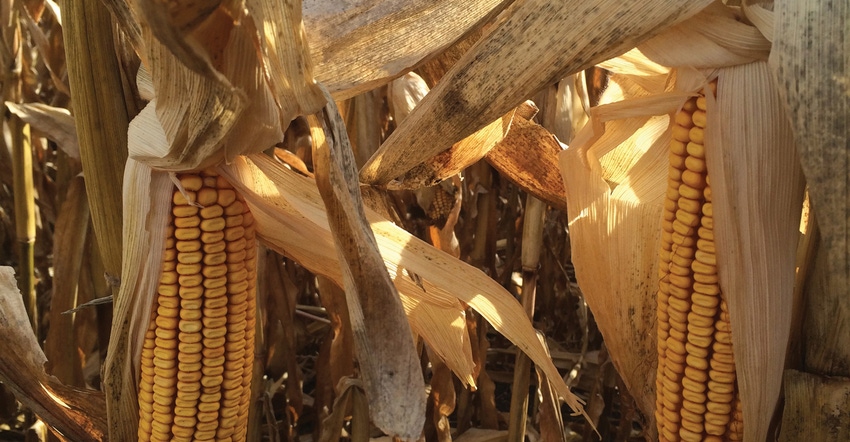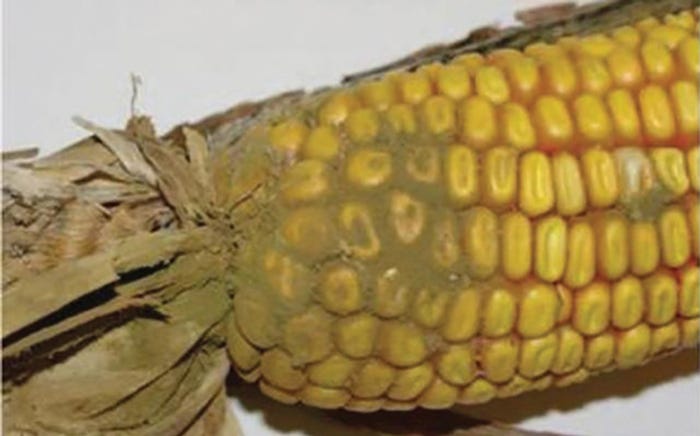Growing conditions line up for presence of mycotoxins in corn.

Adverse weather conditions of flooding, drought and early frosts can really put a damper on a corn crop by lowering yields, test weights and overall grain quality.
Another side effect is that these adverse weather conditions make a perfect storm for the development of mycotoxins in the grain that can prove sickening — and even deadly — for livestock that will be fed the grain down the road.
Ryan Samuel, a South Dakota State University assistant professor and Extension swine specialist, says such conditions presented themselves throughout the United States this corn growing season, putting hog producers on high alert to handle and manage potentially tainted grain properly. Adding insult to injury, Samuel says the 2018 growing season presented its own conditions that promoted the presence of mycotoxins in last year's corn crop.
"One of the biggest things that we recommend is to actually get the corn tested, and then you know what mycotoxins are present, and what levels of mycotoxins you have in the grain," Samuel says, adding that if one mycotoxin is detected, it's likely there are others of the 40-some different mycotoxins also present in the grain sample.

Getting a good sample
Samuel adds that the key to getting a good test is in the sampling. "This is an issue because it's hard to get a representative sample of what you're looking at, because mycotoxins occur in pockets — so how do you sample that appropriately and make sure that you get a good representative sample to send off" to the lab?
It is suggested that producers take corn samples from at least 10 different locations in the bin or truck, mix the samples and send that subsample to the lab in a cloth or paper bag for testing.
Upon receiving the test results, Samuel suggests that producers sit down with their nutritionists to develop the best strategy for feeding the tainted grain, whether it be mixing the tainted grain with clean grain, or using a mycotoxin mitigant on the grain to lower the mycotoxins to an acceptable level. He adds that the practice of mixing tainted grain with clean grain may prove difficult, with the aforementioned back-to-back crop seasons with mycotoxin-friendly conditions.
If mycotoxins are present in the grain, a producer should consider adding a mold inhibitor to the grain as it goes into storage to prevent any additional mold growth. Also, research has shown that mold growth and mycotoxin production in the complete feed can happen even in the feeders once the corn is ground, since barns are typically warmer and more humid than the outdoors.
The main mycotoxins that affect pig performance are aflatoxin (suppressed immune system and death), zearalenone (reproductive issues), vomitoxin or deoxynivalenol (feed refusal) and fumonisins (respiratory issues). Not all mycotoxins are created equal, as each carries different maximum recommended concentrations in diets for grower and finishing pigs.
For example, the maximum level for aflatoxin in finishing diets is 200 parts per billion; zearalenone, 1 part per million in grower diets and 3 parts per million in finishing diets; vomitoxin or deoxynivalenol, 1 part per million in grower and finishing diets; and fumonisins, 5 parts per million in grower and finishing diets. Again, the importance of testing grain samples is stressed.
It should be pointed out that not all molds are bad; some of the visible black, smutty molds on corn may look bad, but they do not negatively impact pig performance.
Even after developing a feeding strategy, hog producers cannot turn a blind eye to what's going on in the barns.
"You really need to follow up and see if you're getting the results that you expect from the strategy you're applying," he says. "Keep in mind, there's potential of your batches of corn or places in the feed bin, whether you've got hot spots or not in there, and if it's changed over time." Retesting of the grain may be appropriate, again making sure to get a representative sample.

Trust the pig
As always holds true, Samuel says to trust your pigs, because they will tell you what's going on the barn and within themselves.
"Watch the animals — they'll tell you," he says, "We've got some of those [mycotoxins] like deoxynivalenol, which is otherwise known as vomitoxin, for that reason, because that's all you'll see the animals doing."
Observation of pigs will also alert producers to the presence of mycotoxins if they thought they had been feeding mycotoxin-free feed, as pigs may not eat the feed if it tastes or smells bad to them.
Depending on the producer's operation, there may be options for using the mixes of tainted and fresh feed grain. "You've got to keep it out of the breeding, period; lactation and out of the nursery, for sure," he says. "Feeding that, maybe through gestation, depending on which mycotoxins they are, so the ones that have reproductive or estrogen-like properties are not ones you want to have in there; but bred animals should be able to handle those more than the nursery pigs."
Though producers may be able to feed tainted-corn feed to market hogs without too many adverse health effects, they may experience falloff in feed efficiency. "But if you can afford to balance that out of losing a little bit on feed efficiency, but you can actually feed that grain without more input costs — and that may pay off," Samuel says.
Producers who opt to use a mycotoxin mitigant to balance their hog diets need to be aware of the potential offsetting effects: "The biggest one — and that's an indirect effect — is that if you start putting these into your diet and you've got to take something out," he says.
"So, if your diet's dialed into your energy-protein ratio, and if you add this product in at a certain number of pounds per ton — well, then, it's going to displace some of your corn, and things are going to change in your diet a little bit."
Samuel urges caution to producers who may be thinking of switching feedstuffs if they either cannot find enough good corn, or if they choose not to treat the corn with a mitigating product. "Bad growing conditions that negatively impact corn may also have the same effect on other grains that producers may choose to switch to — wheat or sorghum," he says. "If you wanted to look at different feedstuffs, but unfortunately some of those, like corn DDGS [dried distillers grains with solubles], for example, is one that you're going to actually have higher concentrations of mycotoxins in, because everything concentrates to that production.
"So, pushing up your DDGS in your diet actually could bring you more trouble than feeding the corn itself."
DON data
Crystal Levesque, a colleague of Ryan Samuel's at South Dakota State University, led a team of researchers (including Samuel) in a study to evaluate the effect of pretreating dietary deoxynivalenol-contaminated dried distillers grains with solubles with sodium bisulfite on growing pig performance. The SDSU team conducted the research with ethanol producer Poet Inc., based in Sioux Falls, S.D.
During this study, which was completed in 2018, 247 growing pigs (55.3 ± 4.6 pounds) were randomly allotted to 18 pens (13 to 14 pigs per pen). The pigs were fed one of three experimental diets (six pens per diet) for 21 days. The three diets were corn-soybean meal based with 30% mycotoxin-free DDGS; DON-contaminated DDGS; or pretreated, DON-contaminated DDGS.
Data were collected, and observations of pigs were noted as to the performance and visible signs of adverse effects on the pigs. This study suggests that DON levels in mixed diets at up to two times Food and Drug Administration-recommended levels may be a strategy for use of DON-contaminated corn in growing pigs, provided pigs have sufficient time to develop tolerance and experience "catch-up" growth.
Click here for a full report of research by Levesque's team.
About the Author(s)
You May Also Like


